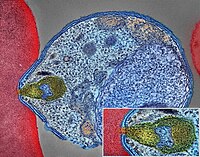
Investigating disease severity in an animal model of concurrent babesiosis and Lyme disease.
Sign Up to like & getrecommendations! Published in 2019 at "International journal for parasitology"
DOI: 10.1016/j.ijpara.2018.06.006
Abstract: The incidence of babesiosis, Lyme disease and other tick-borne diseases has increased steadily in Europe and North America during the last five decades. Babesia microti is transmitted by species of Ixodes, the same ticks that… read more here.
Keywords: infection; lyme disease; disease; microti ... See more keywords

Giardia microti in pet Microtus guentheri: Evidence of a parasite never detected in Italy.
Sign Up to like & getrecommendations! Published in 2020 at "Parasitology international"
DOI: 10.1016/j.parint.2020.102207
Abstract: The genus Giardia includes several species distinguished by morphological, biological and molecular features. Currently, eight species within the genus are retained as valid. In Italy no identification of Giardia species other than Giardia duodenalis has… read more here.
Keywords: microti pet; giardia; microti; giardia microti ... See more keywords

In vivo activity and atom pair fingerprint analysis of MMV665941 against the apicomplexan parasite Babesia microti, the causative agent of babesiosis in humans and rodents
Sign Up to like & getrecommendations! Published in 2022 at "Pathogens and Global Health"
DOI: 10.1080/20477724.2022.2128571
Abstract: ABSTRACT The effect of MMV665941 on the growth of Babesia microti (B. microti) in mice, was investigated in this study using a fluorescence-based SYBR Green I test. Using atom Pair signatures, we investigated the structural… read more here.
Keywords: mmv665941; growth; babesiosis; microti ... See more keywords

Human babesiosis, an infectious disease caused by protozoa: transmission, pathogenesis, symptoms, diagnosis, and treatment –correspondent
Sign Up to like & getrecommendations! Published in 2023 at "Annals of Medicine and Surgery"
DOI: 10.1097/ms9.0000000000000567
Abstract: Babesiosis is caused by microscopic parasites that target red blood cells and are spread by certain ticks. The two areas of the country where tick-borne transmission is most common are the Northeast and upper Midwest,… read more here.
Keywords: babesia species; transmission; babesiosis; human babesiosis ... See more keywords

Zoonotic Babesia microti infection in wild rodents in Erzurum province, northeastern Turkey
Sign Up to like & getrecommendations! Published in 2022 at "Zoonoses and Public Health"
DOI: 10.1111/zph.12983
Abstract: Wild rodents are natural reservoir hosts of various pathogens, including Babesia microti. This study investigated the presence of B. microti in rodents from Erzurum province in Turkey. A total of 498 rodents and 21 rodent‐fed… read more here.
Keywords: wild rodents; babesia; microti; erzurum province ... See more keywords

Host Contributions to the Force of Borrelia burgdorferi and Babesia microti Transmission Differ at Edges of and within a Small Habitat Patch
Sign Up to like & getrecommendations! Published in 2022 at "Applied and Environmental Microbiology"
DOI: 10.1128/aem.02391-21
Abstract: Habitat fragmentation is thought to be a main factor in the emergence of Lyme disease and other deer tick-transmitted infections. The patchwork of forest and edges promotes altered biodiversity, favoring the abundance of generalist rodents,… read more here.
Keywords: lyme disease; transmission; microti; deer ... See more keywords

BmGPAC, an Antigen Capture Assay for Detection of Active Babesia microti Infection
Sign Up to like & getrecommendations! Published in 2018 at "Journal of Clinical Microbiology"
DOI: 10.1128/jcm.00067-18
Abstract: Human babesiosis is an emerging zoonotic infectious disease caused by intraerythrocytic protozoan parasites of the genus Babesia. Most cases of human babesiosis are caused by Babesia microti and often manifest in individuals over the age… read more here.
Keywords: microti infections; babesia microti; infection; detection active ... See more keywords

Temporal metabolic profiling of erythrocytes in mice infected with Babesia microti.
Sign Up to like & getrecommendations! Published in 2022 at "Microbial pathogenesis"
DOI: 10.2139/ssrn.4225801
Abstract: BACKGROUND Babesiosis is an emerging zoonosis worldwide that is caused by tick-borne apicomplexans, Babesia spp., which threatens the health of domesticated and wild mammals and even humans. Although it has done serious harm to animal… read more here.
Keywords: mice infected; temporal metabolic; infection; microti ... See more keywords

Babesia microti Confers Macrophage-Based Cross-Protective Immunity Against Murine Malaria
Sign Up to like & getrecommendations! Published in 2020 at "Frontiers in Cellular and Infection Microbiology"
DOI: 10.3389/fcimb.2020.00193
Abstract: Malaria and babesiosis, the two primary intraerythrocytic protozoan diseases of humans, have been reported in multiple cases of co-infection in endemic regions. As the geographic range and incidence of arthropod-borne infectious diseases is being affected… read more here.
Keywords: chabaudi; babesia microti; infection; cross ... See more keywords

A Novel Thioredoxin-Like Protein of Babesia microti Involved in Parasite Pathogenicity
Sign Up to like & getrecommendations! Published in 2022 at "Frontiers in Cellular and Infection Microbiology"
DOI: 10.3389/fcimb.2022.826818
Abstract: Babesiosis poses a serious threat to immunocompromised individuals and the major etiological species of Babesia for human babesiosis is Babesia microti. Merozoites are a critical stage in the life cycle of Babesia microti. Several merozoite… read more here.
Keywords: microti; like protein; babesia microti; protein ... See more keywords

Babesia microti Aldo-keto Reductase-Like Protein Involved in Antioxidant and Anti-parasite Response
Sign Up to like & getrecommendations! Published in 2017 at "Frontiers in Microbiology"
DOI: 10.3389/fmicb.2017.02006
Abstract: The intraerythrocytic apicomplexan Babesia microti is the primary causative agent of human babesiosis, which is an infectious disease that occurs in various regions around the world. Although the aldo-keto reductases (AKRs) of this parasite have… read more here.
Keywords: aldo keto; bmakr; microti aldo; babesia microti ... See more keywords